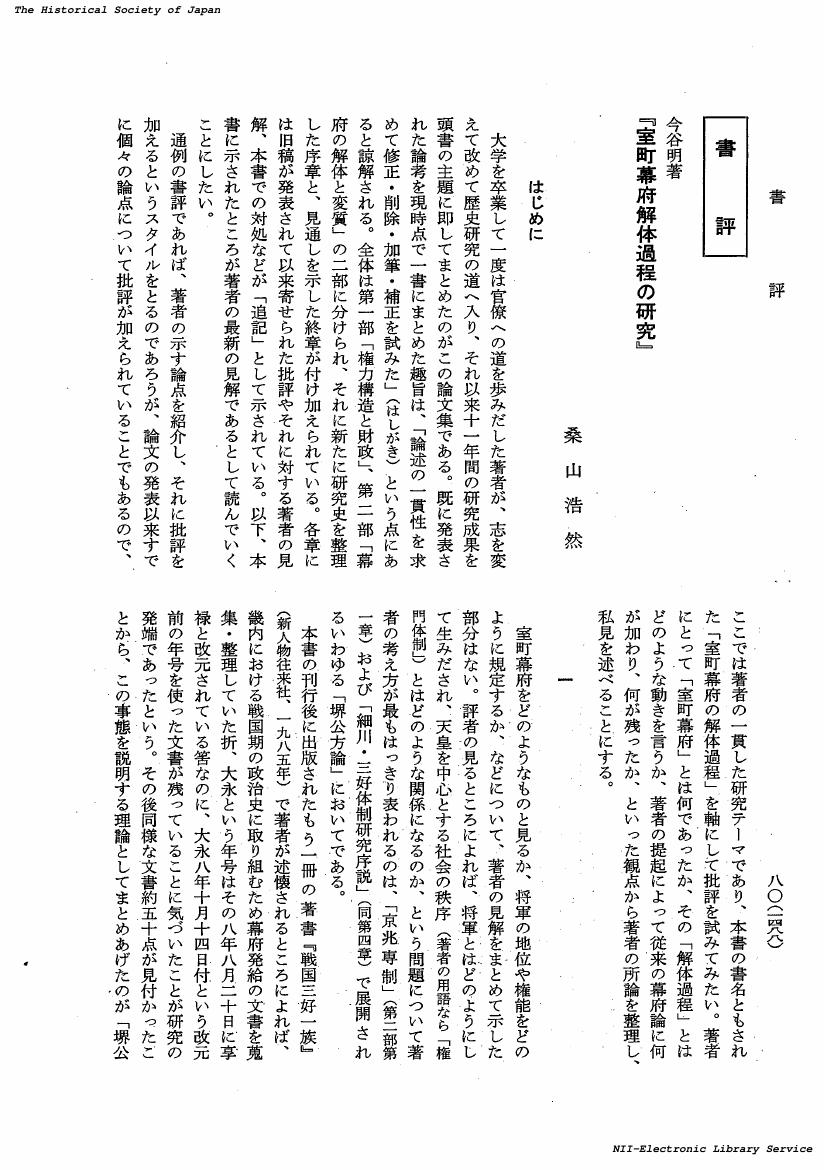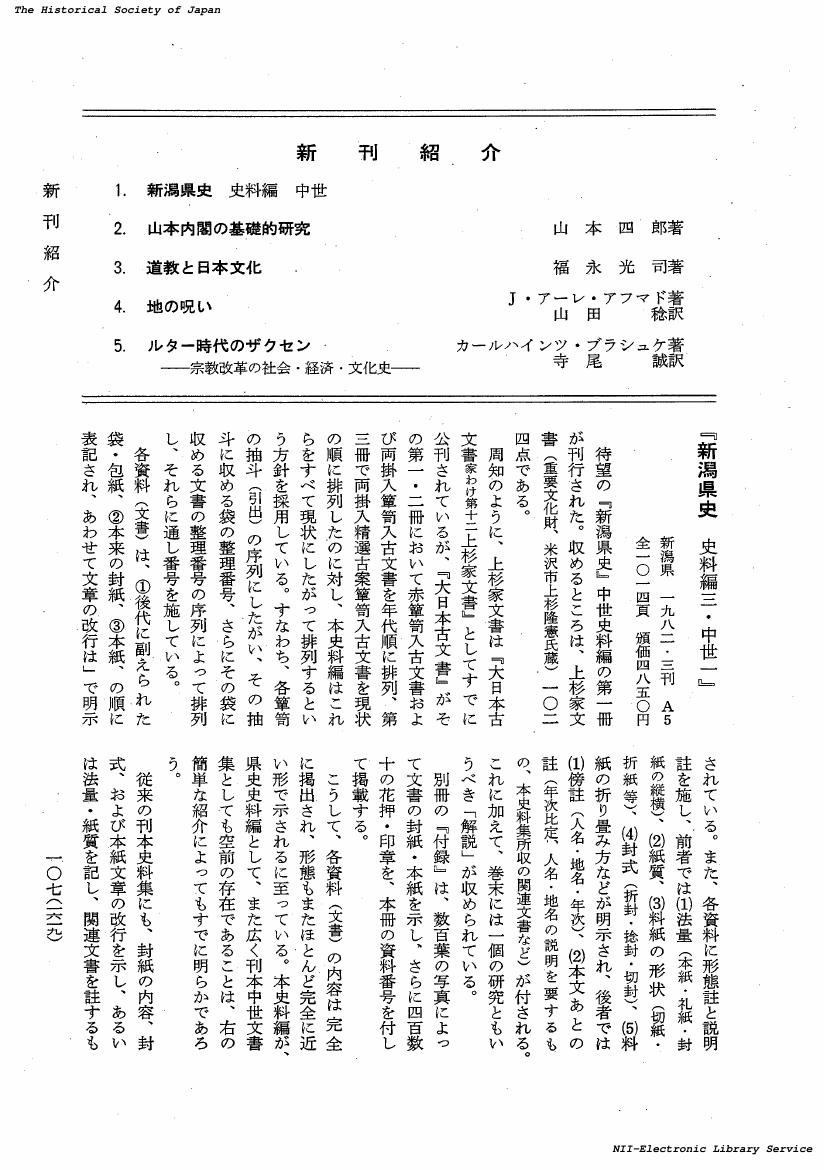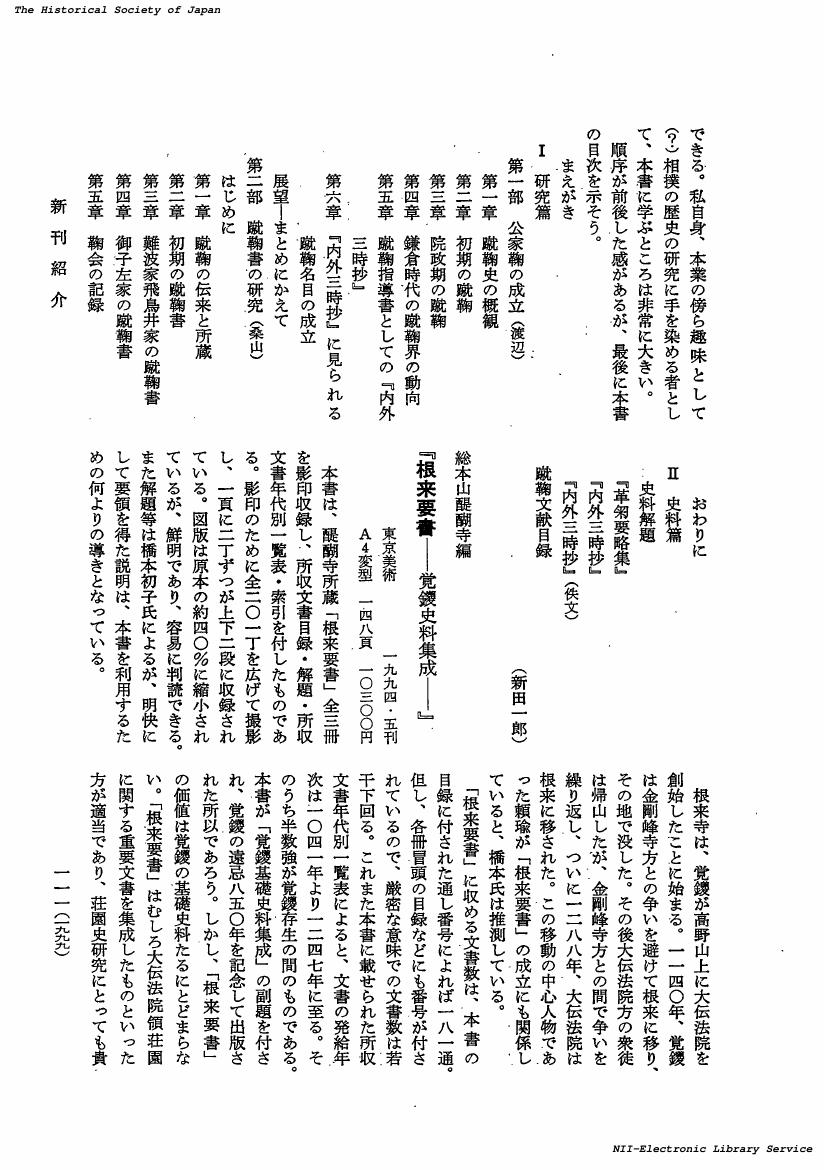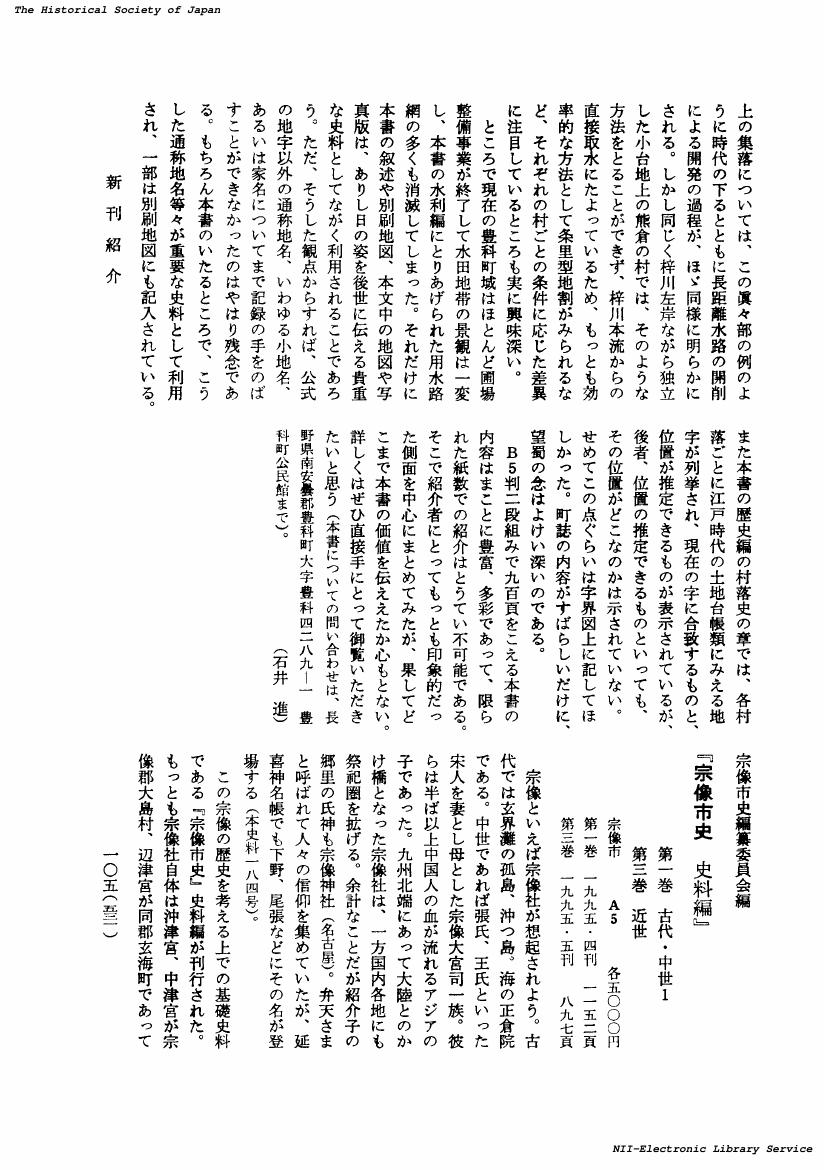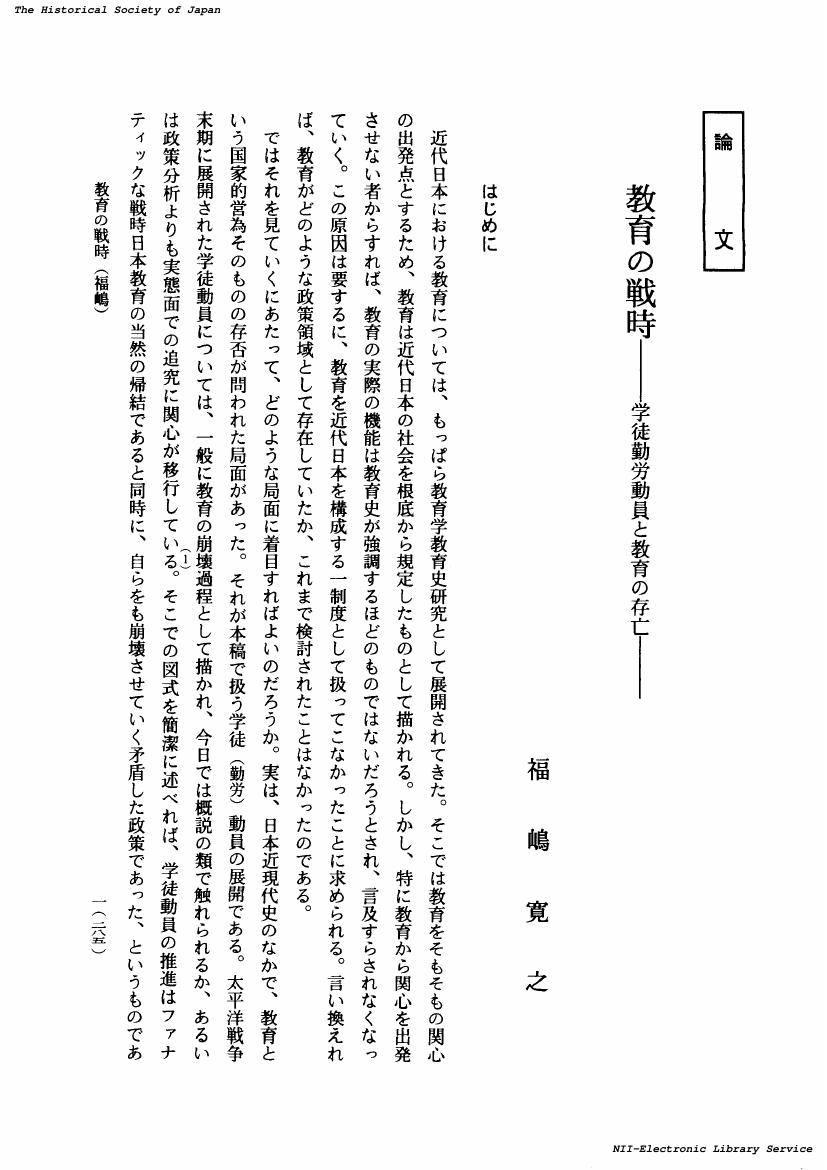5 0 0 0 奥羽仕置と会津領の知行基準 : 「永楽銭」基準高の特質をめぐって
- 著者
- 川戸 貴史
- 出版者
- 公益財団法人 史学会
- 雑誌
- 史学雑誌 (ISSN:00182478)
- 巻号頁・発行日
- vol.123, no.4, pp.511-544, 2014
This article examines the peculiar characteristics of cadasters conducted during the Toyotomi Hideyoshi regime by focusing on why the currency described as "eirakusen" 永楽銭 (originally denoting copper coins minted during the Ming Dynasty's Yongle 永楽 era) was adopted in 1590 as the standard for taxation (kandaka 貫高) in Aizu, which was part of the territory under the feudal lords of Mutsu and Dewa Provinces chastised by Hideyoshi in the Ou Shioki 奥羽仕置 of 1590. The reason for basing land taxes on "eirakusen" instead of rice output (kokudaka 石高) in the Aizu fief was because 1) the kandaka system was already functioning in Aizu prior to the Shioki and 2) it was deemed necessary to secure and occupy the territory as quickly as possible. Upon his arrival in Aizu, Gamo Ujisato, to whom Hideyoshi had granted the fief under the Shioki's provisions, began collecting tribute. Although the research to date purports that half of the tribute was rendered in rice and the other in money, the author argues that the process was not exactly that straight forward; for payment in money was the rule, and according to the tax ledgers, the denomination was "eirakusen". Based on this conclusion the author turns to the question of what sort of currency "eirakusen" actually was. After comparing the "eirakusen" actually levied as tribute with the value of gold during the time in question, the author finds that "eirakusen" was worth about the same as the normal currency of the day, leading him to conclude that in this case "eirakusen" did not denote Ming Yongle era Chinese coins and had no special value. Noting the fact that in the feudal territory of the Gohojo Clan immediately before its downfall that the value of Ming Yongle era coins was regarded as more valuable than other coins, the Toyotomi regime mistakenly assumed that this was true throughout Mutsu and Dewa, and accordingly established that currency, which it called "eirakusen", as the means of tribute payment in the provisions of the Shioki. Since Ming Yongle era coins were in fact not circulating in the region, the "eirakusen" unit of tribute set in Aizu did not exist in form, but only as entries on the pages of tax ledgers. Consequently, the "eirakusen" ledger entries had to be converted into circulating currency and rice at fixed rates of exchange before tribute could be collected. Although land policy in territories occupied by the Toyotomi regime often seems to have flexibly responded to what was actually happening on the ground, there were cases in which the process of preparing its system of military vassalage would become so hectic that even local monetary currency circulation practices were not sufficiently understood.
5 0 0 0 OA 1930年代の廃娼運動 : 公娼廃止から性教育へ
- 著者
- 小野沢 あかね
- 出版者
- 公益財団法人 史学会
- 雑誌
- 史学雑誌 (ISSN:00182478)
- 巻号頁・発行日
- vol.106, no.7, pp.1319-1339,1418-, 1997-07-20 (Released:2017-11-30)
The purpose of this paper is to make clear the evolution and logic of the repeal movement against licensed prostitution by the Japan Women's Christian Temperance Union (JWCTU) during the 1930s in Nagano prefecture. At that time licensed prostitution was declining, while, according to the newspapers, "modern" private prostitution solicited by hostesses in cafes was increasing. In Nagano Prefecture, a motion in the prefectural assembly calling for the repeal of licensed prostitution was passed in 1930. At the same time, a motion permitting and regulating private prostitution tacitly was passed. After that, the prefecture and the police required cafe hostesses to pay a tax and be inspected for venereal disease. The JWCTU, which made much of monogamy and child-rearing, insisted that licensed prostitution was sexism and exerted a bad influence on children, because it encouraged human traffic, venereal disease, and demoralization. Therefore, the JWCTU felt that repealing licensed prostitution was the first thing to do to root out all prostitution, and lobbying passage of the motion against licensed prostitution was given the highest priority. In order to get the support of the many members in the prefectural assembly who were not against prostitution, the repealers changed the main point of the motion; but this change was only a strategy, as the goals of the movement themselves did not change. The fact that the JWCTU was against a motion reflecting licensed brothel keepers' interests proves this point. After the passage of the motion, the JWCTU held a lecture on sex education attempting to improve girls' self-confidence about sex and boys' respect for girls. The idea of sex education in the 1930s was almost the same as the logic of the repeal movement during the 1920s. The plan of a "women's home" was also based on this idea of sex education. On the other hand, the idea of sex education encouraged the JWCTU to demand to the regulation of hostesses and cafes, in order to keep them out of their residential areas.
5 0 0 0 OA 日本 : 中世 三(一九九〇年の歴史学界 : 回顧と展望)
- 著者
- 古澤 直人
- 出版者
- 公益財団法人 史学会
- 雑誌
- 史学雑誌 (ISSN:00182478)
- 巻号頁・発行日
- vol.100, no.5, pp.687-690, 1991-05-20 (Released:2017-11-29)
5 0 0 0 OA 今谷明著『室町幕府解体過程の研究』
- 著者
- 桑山 浩然
- 出版者
- 公益財団法人 史学会
- 雑誌
- 史学雑誌 (ISSN:00182478)
- 巻号頁・発行日
- vol.96, no.9, pp.1488-1498, 1987-09-20 (Released:2017-11-29)
5 0 0 0 OA 西岡虎之助編『日本荘園絵図集成 上』, 東京堂出版, 一九七六・四刊, A4, 二五〇頁
- 著者
- 瀬田 勝哉
- 出版者
- 公益財団法人 史学会
- 雑誌
- 史学雑誌 (ISSN:00182478)
- 巻号頁・発行日
- vol.85, no.11, pp.1584-1586, 1976-11-20 (Released:2017-10-05)
5 0 0 0 OA 西岡虎之助編『日本荘園絵図集成 下』, 東京堂出版, 一九七七・五刊, A4, 三六〇頁
- 著者
- 瀬田 勝哉
- 出版者
- 公益財団法人 史学会
- 雑誌
- 史学雑誌 (ISSN:00182478)
- 巻号頁・発行日
- vol.87, no.6, pp.1065-1068, 1978-06-20 (Released:2017-10-05)
5 0 0 0 OA 『新潟県史 史料編三・中世一』, 新潟県, 一九八二・三刊, A5, 全一〇四頁
- 著者
- 小林 清治
- 出版者
- 公益財団法人 史学会
- 雑誌
- 史学雑誌 (ISSN:00182478)
- 巻号頁・発行日
- vol.91, no.10, pp.1619-1620, 1982-10-20 (Released:2017-11-29)
- 著者
- 田中 博美
- 出版者
- 公益財団法人 史学会
- 雑誌
- 史学雑誌 (ISSN:00182478)
- 巻号頁・発行日
- vol.95, no.3, pp.389-390, 1986-03-20 (Released:2017-11-29)
- 著者
- 神田 千里
- 出版者
- 公益財団法人 史学会
- 雑誌
- 史学雑誌 (ISSN:00182478)
- 巻号頁・発行日
- vol.101, no.1, pp.126-127, 1992-01-20 (Released:2017-11-29)
- 著者
- 五味 文彦
- 出版者
- 公益財団法人 史学会
- 雑誌
- 史学雑誌 (ISSN:00182478)
- 巻号頁・発行日
- vol.95, no.7, pp.1237-1239, 1986-07-20 (Released:2017-11-29)
- 著者
- 近藤 成一
- 出版者
- 公益財団法人 史学会
- 雑誌
- 史学雑誌 (ISSN:00182478)
- 巻号頁・発行日
- vol.103, no.11, pp.1999-2000, 1994-11-20 (Released:2017-11-30)
- 著者
- 石井 進
- 出版者
- 公益財団法人 史学会
- 雑誌
- 史学雑誌 (ISSN:00182478)
- 巻号頁・発行日
- vol.96, no.8, pp.1372-1374, 1987-08-20 (Released:2017-11-29)
- 著者
- 石井 進
- 出版者
- 公益財団法人 史学会
- 雑誌
- 史学雑誌 (ISSN:00182478)
- 巻号頁・発行日
- vol.104, no.2, pp.253-254, 1995-02-20 (Released:2017-11-30)
5 0 0 0 OA 宗像市史編纂委員会編『宗像市史, 史料編』第一巻, 古代・中世1, 第三巻, 近世, 宗像市, A5, 各五〇〇〇円, 第一巻, 一九九五・四刊, 一一五二頁, 第3巻, 一九九五・五刊, 八九七頁
- 著者
- 服部 英雄
- 出版者
- 公益財団法人 史学会
- 雑誌
- 史学雑誌 (ISSN:00182478)
- 巻号頁・発行日
- vol.105, no.6, pp.531-533, 1996-06-20 (Released:2017-11-30)
5 0 0 0 復古王政期におけるフランス革命の記憶
- 著者
- 遅塚 忠躬
- 出版者
- 公益財団法人 史学会
- 雑誌
- 史学雑誌 (ISSN:00182478)
- 巻号頁・発行日
- vol.110, no.12, pp.2059-2093, 2001
Article 7 of the "Amnesty Bill of 1816" decreed "regicides" (deputies of the National Convention who had voted for the death of Louis XVI) to be exempted from amnesty, and it condemned the regicides who had joined Napoleon's hundred days to go into exile forever out of the French kingdom. However, several regicides continued to live in France (those who had not joined Napoleon, who had been granted a stay of execution, and who had gone underground). The central and local police agencies were very cautious of these regicides living in France, because it was possible that the memories of the Revolution connected with the regicide survivors would be menacing to the Restoration monarchy. The authorities were so cautious of this dangerous movement that there are many documents about it in the dossiers of the Ministery of Police. This paper aims to shed light on some aspects of the memories of the Revolution under the Restoration by investigating these police documents (F7 in the National Archives). The results of the research are as follows. First, the most positive and favourable memories of the Revolution were held, grosso modo, among the peasantry and popular classes, while the most negative and disfavourable ones were held among local rich notables. Secondly, this social distinction of memories having been complicated according to local situations, frictions between positive and negative memories took place in various forms. Thirdly, among the peasantry and popular classes, positive memories of the Revolution were maintained in the same formula (the Revolution which had abolished feudal dues) throughout the Restoration, while among local notables and bourgeois, memories of the Revolution tended to fade away or be forgotten in the early days of the Restoration. Finally, if we look ahead into the second half of the19th century, the succession of memories of the Revolution would not be so straightforward. That is to say, memories of the Revolution would be transformed, resurrected and, at the same time, forged or invented, up to the Third Republic.
- 著者
- 大島 明子
- 出版者
- 公益財団法人 史学会
- 雑誌
- 史学雑誌 (ISSN:00182478)
- 巻号頁・発行日
- vol.117, no.7, pp.1219-1252, 2008
In the research to date on government-military relations regarding the Japanese Army, emphasis has been put mainly on the relationship between party cabinets and the military high command. However, during the period between the establishment of a prefectural system to replace Tokugawa period feudal domains and the setting up of an independent general staff office (i.e., during the formation of Japan's modern armed forces), the Army consisted of groups affiliated to the feudal domains, resulting in ambiguity concerning the chain of command. Moreover, in the midst of clear divisions between civilian politicians manning the Cabinet (Sei'in 正院) and military personnel, opinions were divided over how a modern army should be formed; add in the political struggle brewing over the Treasury's jurisdiction over local entities, and there was an eminent danger of the Army disintegrating into smaller factions. Within this situation, the Ministry of the Army was granted broad powers, including control over personnel and military command, and enjoyed relative autonomy from the Cabinet in forming a modern army. However, from 1872-73, during which time the Imperial Guard was reorganized from troops sent by three powerful feudal domains to soldiers from divers regions, a plan was advanced by officers affiliated with Satsuma Domain and Minister of Foreign Affairs Soejima Taneomi 副島種臣 to invade Taiwan, and the Cabinet followed suit with plans of its own to recruit former feudal domain troops to form an expeditionary force. This article interprets these events as a political struggle between the Cabinet and the Ministry of the Army over military authority, and focuses on the participation of the Cabinet's Legislative Bureau (Sa'in 左院) at a time when it was aiming at both the abolition of the feudal status system and constitutional reform. The Legislative Bureau spontaneously cooperated in establishing a military conscription act and approached Tosa Domain with a plan for a "parliamentary body" that would deliberate on military affairs. An examination of this political process makes it possible to reinterpret political-military relations at that time in terms of a triangle involving the Cabinet, the Ministry of the Army and the Legislative Bureau (along with its regional administrators). What ultimately happened was that in June or July of 1873, a group led by councillor (sangi) Itagaki Taisuke of Tosa Domain halted the Legislative Bureau's attempts at constitutional reform by introducing a proposal to invade Korea, which led to political gridlock and the resignation of the invasion supporters in October. This incident should therefore be considered on two levels: constitutional reform vs. centralization of Cabinet power, and the struggle between the Ministry of the Army and the Cabinet over command of the military.
- 著者
- 大井 知範
- 出版者
- 公益財団法人史学会
- 雑誌
- 史學雜誌 (ISSN:00182478)
- 巻号頁・発行日
- vol.124, no.2, pp.177-209, 2015-02-20
This paper attempts to elicit the reality of the Hapsburg Empire's global seafaring prowess despite its reputation as a mainly continental power, in light of historical findings that an Imperial warship had been stationed in the seas of East Asia approximately 100 years ago. Research regarding Western navies stationed overseas has in the past focused largely on their use as a means of military competition or imperialistic ambitions toward the non-Western world. However, here the author points to another purpose with which warships were deployed overseas; namely, to serve as media for promoting international relations within the daily routine of peacetime conditions. After outlining the deployment system of warships outside of the region of Europe, and the reasons, circumstances and substance of the Hapsburg Empire's stationing of a warship in East Asian waters, the author turns to the specific duties of the ship, in particular, how it performed the very important duty of any Western navy in protecting its country's citizen and commercial interests in the region. However, since the Hapsburg Empire had no overseas interests or citizens to protect in East Asia, it was impossible for the Austro-Hungarians to set up a system of direct protection like that of the other major powers, due mainly to its unique position in having only a single warship to accommodate such needs. The author then addresses the subject of goodwill exchange, which he considers to be the most important daily routine of the Hapsburg warship, and looks there for the ultimate reason for stationing it in East Asian waters. Finally, he focuses on the military band on board the ship, in order to clarify the fact that the Hapsburg Empire was concerned in identifying with maritime coastal society in East Asia through the medium of music. The Hapsburg Empire thus intended to adapt to the imperial order as a major power in East Asia by carefully cultivating various daily peacetime routines.
5 0 0 0 OA 教育の戦時 : 学徒勤労動員と教育の存亡
- 著者
- 福嶋 寛之
- 出版者
- 公益財団法人 史学会
- 雑誌
- 史学雑誌 (ISSN:00182478)
- 巻号頁・発行日
- vol.114, no.3, pp.285-318, 2005-03-20 (Released:2017-12-01)
5 0 0 0 OA 豊臣政権の算用体制
- 著者
- 谷 徹也
- 出版者
- 公益財団法人 史学会
- 雑誌
- 史学雑誌 (ISSN:00182478)
- 巻号頁・発行日
- vol.123, no.12, pp.2125-2148, 2014-12-20 (Released:2017-07-31)
The large body of research literature that has accumulated to date on the direct landholdings (kurairi-chi 蔵入地) of the Toyotomi Hideyoshi regime, which formed its power base, has run the gamut from identifying the locations of those holdings to the role they played in funding Hideyoshi's military forays into the Korean Peninsula. The present article attempts to reexamine this research by focusing on the means by which the regime's leaders who administered kurairi-chi went about settling accounts related to it, and in so doing describe in substantive terms such aspects as the regime's internal structure and the remission of rice (kuramai 蔵米) harvested from its landholdings. The author begins with a review of the various fiscal documents related to kurairi-chi; namely, kirifu 切符, uketori-jo 請取状 and kaisai-jo 皆済状 Kirifu was a document drawn up to indicate how kuramai was to be used, addressed to the manager of a kurairi-chi holding and specifying to whom the rice was to be allotted, while uketori-jo was a certificate of receipt for rice remitted to the regime in the form of cash. Kaisai-jo, which was issued in the settlement of accounts and whose function was assumed in 1590 by the sanyo-jo 算用状, recorded the information contained in the kirifu (allotment) and uketori-jo (receipt) related to any transaction. From these documents and the parts of them written directly by Hideyoshi himself, the author concludes that it was Hideyoshi who held the ultimate authority over the regime's expenditures of rice and cash, as well as the determination of tax exemptions (rates) on kurairi-chi holdings, while his functionaries were charged only with settling related accounts. Next the author turns to changes that occurred in the personnel handling the settlement of accounts, beginning with Ito Yozaemon, a Toyotomi retainer with a commercial background, but later reverting to regime functionaries, called Sanyo Bugyo 算用奉行. The staff first consisted of two members, Nakatsuka Masaie and Mashita Nagamori, to whom Asano Nagayoshi and Maeda Gen'i were added. A document dating back to Asano's removal from office in 1595 verifies the office of Sanyo Bugyo as an important administrative group within the regime. Later Ishida Mitsunari would join the staff, then after Hideyoshi's death, the office's duties were incorporated into the Go-bugyo 五奉行 (Five Deputies) system. Finally, following the Battle of Sekigahara, Katagiri Katsumoto and Koide Hidemasa took over the settlement of accounts. Most of the revenue received from kurairi-chi was spent locally, while the portion remitted to the central government was transferred in gold and silver. However, the kurairi-chi managers were almost always late in their submission of copies of tax exemption (rate) lists (men-mokuroku 免目録) and sanyo-jo, to the extent of being fined by the regime for negligence. In light of such a situation, the author concludes that despite the fact that a system of account settlement was firmly put in place within the Toyotomi administrative bureaucracy, the regime was still not able to gain complete managerial control over its kurairi-chi.
- 著者
- 井ノ口 哲也
- 出版者
- 公益財団法人 史学会
- 雑誌
- 史学雑誌 (ISSN:00182478)
- 巻号頁・発行日
- vol.120, no.9, pp.1569-1577, 2011-09-20 (Released:2017-12-01)

